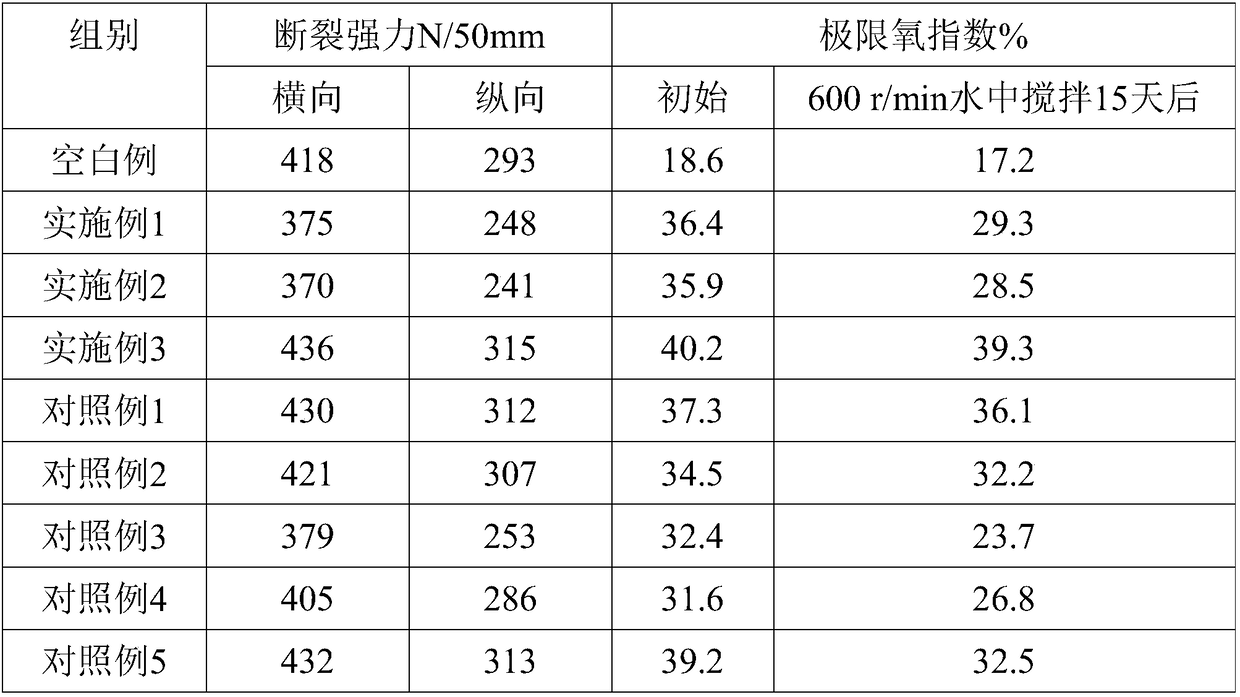Processing technique for flame-retardant plant fiber spunlace nonwoven fabric
A technology for spunlace non-woven fabrics and plant fibers, which is applied in the processing of fiber raw materials, addition of inorganic compounds, addition of non-polymeric organic compounds, etc. It can avoid the sudden decline of flame retardant performance, enhance the adhesion rate and adhesion strength, and achieve the effects of cheap raw material sources.
- Summary
- Abstract
- Description
- Claims
- Application Information
AI Technical Summary
Problems solved by technology
Method used
Image
Examples
Embodiment 1
[0035] Processing of spunlace nonwovens:
[0036] (1) Pulping: first utilize the hydraulic pulper to pulverize the bamboo fiber, and then utilize the refiner and the refiner to refine the pulp to obtain the bamboo fiber slurry;
[0037] (2) Filtration and impurity removal: the prepared bamboo fiber slurry is diluted with water to a mass concentration of 1%, and sent into a slurry tank through a screw pump, and then sent to the impurity removal process through a slurry pump once, using sand removal Filter and pressure sieve to remove impurities, and then sent to high-speed mixer through screw pump;
[0038] (3) flame retardant modification: add flame retardant modifier to the bamboo fiber slurry after filtering and removing impurities, the consumption of flame retardant modifier is 0.5% of bamboo fiber dry weight, and be heated up to 50-55 ℃ high-speed Mix for 10 minutes at a speed of 650 rpm, then continue to heat up to 75-80°C and mix at high speed for 5 minutes at a speed o...
Embodiment 2
[0048] Processing of spunlace nonwovens:
[0049] (1) Pulping: first utilize the hydraulic pulper to pulverize the bamboo fiber, and then utilize the refiner and the refiner to refine the pulp to obtain the bamboo fiber slurry;
[0050] (2) Filtration and impurity removal: the prepared bamboo fiber slurry is diluted with water to a mass concentration of 1%, and sent into a slurry tank through a screw pump, and then sent to the impurity removal process through a slurry pump once, using sand removal Filter and pressure sieve to remove impurities, and then sent to high-speed mixer through screw pump;
[0051] (3) flame retardant modification: add flame retardant modifier to the bamboo fiber slurry after filtering and removing impurities, the consumption of flame retardant modifier is 0.5% of bamboo fiber dry weight, and be heated up to 50-55 ℃ high-speed Mix for 10 minutes at a speed of 650 rpm, then continue to heat up to 75-80°C and mix at high speed for 5 minutes at a speed o...
Embodiment 3
[0061] Processing of spunlace nonwovens:
[0062] (1) Pulping: first utilize the hydraulic pulper to pulverize the bamboo fiber, and then utilize the refiner and the refiner to refine the pulp to obtain the bamboo fiber slurry;
[0063] (2) Filtration and impurity removal: the prepared bamboo fiber slurry is diluted with water to a mass concentration of 1%, and sent into a slurry tank through a screw pump, and then sent to the impurity removal process through a slurry pump once, using sand removal Filter and pressure sieve to remove impurities, and then sent to high-speed mixer through screw pump;
[0064] (3) flame retardant modification: add flame retardant modifier to the bamboo fiber slurry after filtering and removing impurities, the consumption of flame retardant modifier is 0.5% of bamboo fiber dry weight, and be heated up to 50-55 ℃ high-speed Mix for 10 minutes at a speed of 650 rpm, then continue to heat up to 75-80°C and mix at high speed for 5 minutes at a speed o...
PUM
| Property | Measurement | Unit |
|---|---|---|
| Hole diameter | aaaaa | aaaaa |
| Pitch | aaaaa | aaaaa |
Abstract
Description
Claims
Application Information
 Login to View More
Login to View More - R&D Engineer
- R&D Manager
- IP Professional
- Industry Leading Data Capabilities
- Powerful AI technology
- Patent DNA Extraction
Browse by: Latest US Patents, China's latest patents, Technical Efficacy Thesaurus, Application Domain, Technology Topic, Popular Technical Reports.
© 2024 PatSnap. All rights reserved.Legal|Privacy policy|Modern Slavery Act Transparency Statement|Sitemap|About US| Contact US: help@patsnap.com








